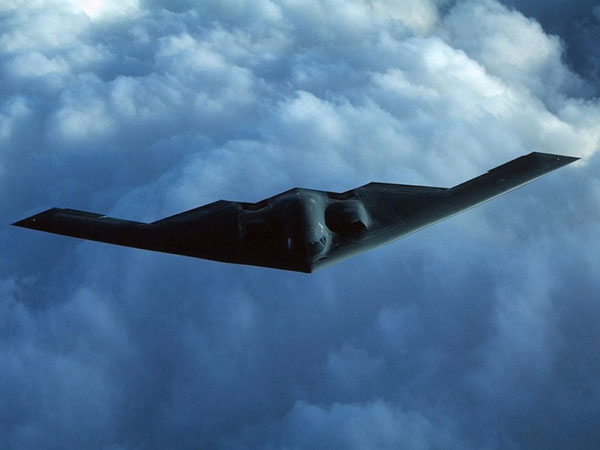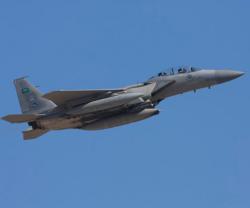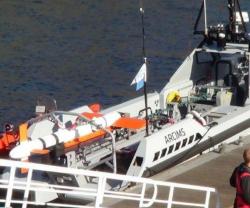NGC Starts Producing EHF SatCom System for B-2 Bomber
12.10.2012 North America
The U.S. Air Force's fleet of B-2 stealth bombers will begin receiving new high-speed processing subsystems under a $108 million low rate initial production contract awarded Sept. 28 to Northrop Grumman Corporation (NGC).
The new hardware and software – which include an integrated processing unit, a high-capacity disk drive, and a network of fiber optic cable – will allow the aircraft to perform advanced communications and weapons delivery missions in the future. The new subsystems are being produced as part of Increment 1 of the Air Force's B-2 extremely high frequency (EHF) satellite communications program.
Northrop Grumman is the Air Force's prime contractor for the B-2 Spirit, the flagship of the nation's long-range strike arsenal and one of the world's most survivable aircraft systems. The B-2 is the only combat-proven stealth platform in the current U.S. inventory.
“The EHF Increment 1 upgrades provide a smart, cost-effective way to enable future combat capability on the B-2. Every current and future upgrade program for the jet will benefit from the quantum leap in processing power and data handling capacity provided by this new hardware and software,” said Ron Naylor, Director of B-2 Modernization and Transformation for Northrop Grumman.
In late July, the EHF Increment 1 hardware and software successfully completed a series of operational tests conducted by the Air Force, Naylor said. The company is also beginning to install the new subsystems in a limited number of aircraft as part of the current EHF Increment 1 system development and demonstration contract.
Each new EHF Increment 1 hardware kit includes:
• An integrated processing unit developed by Lockheed Martin Systems Integration, Owego, New York, that will replace up to a dozen current stand-alone avionics computers on the B-2.
• A disk drive unit developed by Honeywell Defense and Space Electronic Systems, Plymouth, Minnesota, that will enable transfer of EHF data onto and off of the B-2.
• A network of fiber optic cable that will support the high-speed data transfers within the aircraft.
The B-2 is the only long-range, large-payload U.S. aircraft that can penetrate deeply into access-denied airspace. In concert with the Air Force's air superiority fleet, which provides airspace control, and the Air Force's tanker fleet, which enables global mobility, the B-2 can help protect U.S. interests anywhere in the world. It can fly more than 6,000 nautical miles unrefueled and more than 10,000 nautical miles with just one aerial refueling, giving it the ability to reach any point on the globe within hours.
The new hardware and software – which include an integrated processing unit, a high-capacity disk drive, and a network of fiber optic cable – will allow the aircraft to perform advanced communications and weapons delivery missions in the future. The new subsystems are being produced as part of Increment 1 of the Air Force's B-2 extremely high frequency (EHF) satellite communications program.
Northrop Grumman is the Air Force's prime contractor for the B-2 Spirit, the flagship of the nation's long-range strike arsenal and one of the world's most survivable aircraft systems. The B-2 is the only combat-proven stealth platform in the current U.S. inventory.
“The EHF Increment 1 upgrades provide a smart, cost-effective way to enable future combat capability on the B-2. Every current and future upgrade program for the jet will benefit from the quantum leap in processing power and data handling capacity provided by this new hardware and software,” said Ron Naylor, Director of B-2 Modernization and Transformation for Northrop Grumman.
In late July, the EHF Increment 1 hardware and software successfully completed a series of operational tests conducted by the Air Force, Naylor said. The company is also beginning to install the new subsystems in a limited number of aircraft as part of the current EHF Increment 1 system development and demonstration contract.
Each new EHF Increment 1 hardware kit includes:
• An integrated processing unit developed by Lockheed Martin Systems Integration, Owego, New York, that will replace up to a dozen current stand-alone avionics computers on the B-2.
• A disk drive unit developed by Honeywell Defense and Space Electronic Systems, Plymouth, Minnesota, that will enable transfer of EHF data onto and off of the B-2.
• A network of fiber optic cable that will support the high-speed data transfers within the aircraft.
The B-2 is the only long-range, large-payload U.S. aircraft that can penetrate deeply into access-denied airspace. In concert with the Air Force's air superiority fleet, which provides airspace control, and the Air Force's tanker fleet, which enables global mobility, the B-2 can help protect U.S. interests anywhere in the world. It can fly more than 6,000 nautical miles unrefueled and more than 10,000 nautical miles with just one aerial refueling, giving it the ability to reach any point on the globe within hours.
Previous PostBoeing Wins $2 Billion C-17 Sustainment Contract
Latest news
Latest events
Paris Air Show
16 - 22 Jun 2025Paris Le Bourget - FranceDefenPol China2025 - 7th Guangzhou International Defense & Police Exhibition & Summit
11 - 12 Jul 2025Nan Fung International Convention & Exhibition Center (NICEC) - ChinaIDEF 2025 Turkey - International Defence Industry Fair
22 - 27 Jul 2025Istanbul Expo Center - TurkeyDSEI 2025
09 - 12 Sep 2025Excel, London - United Kingdom






















